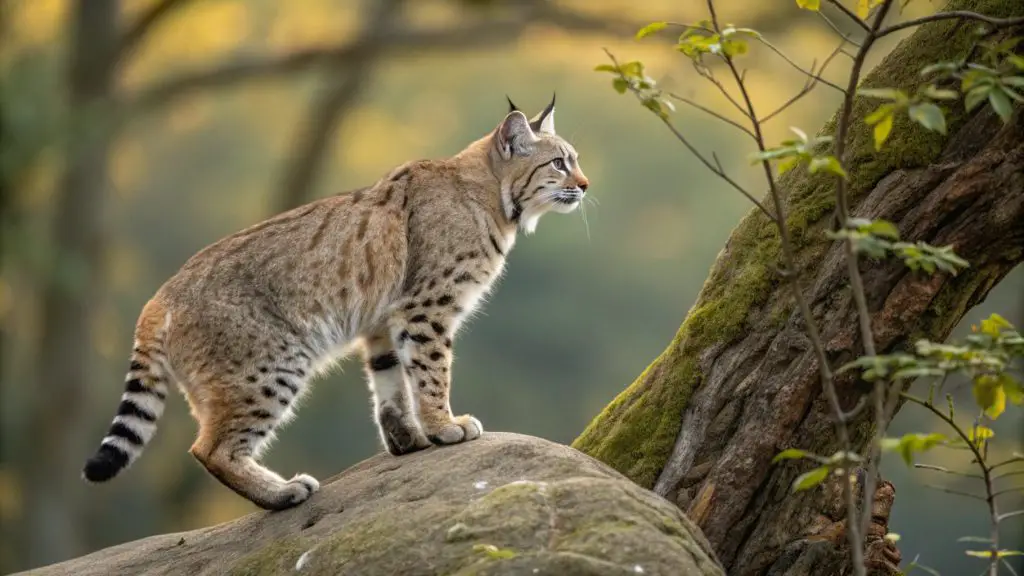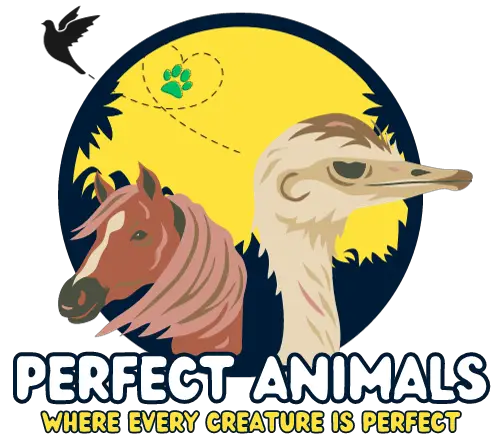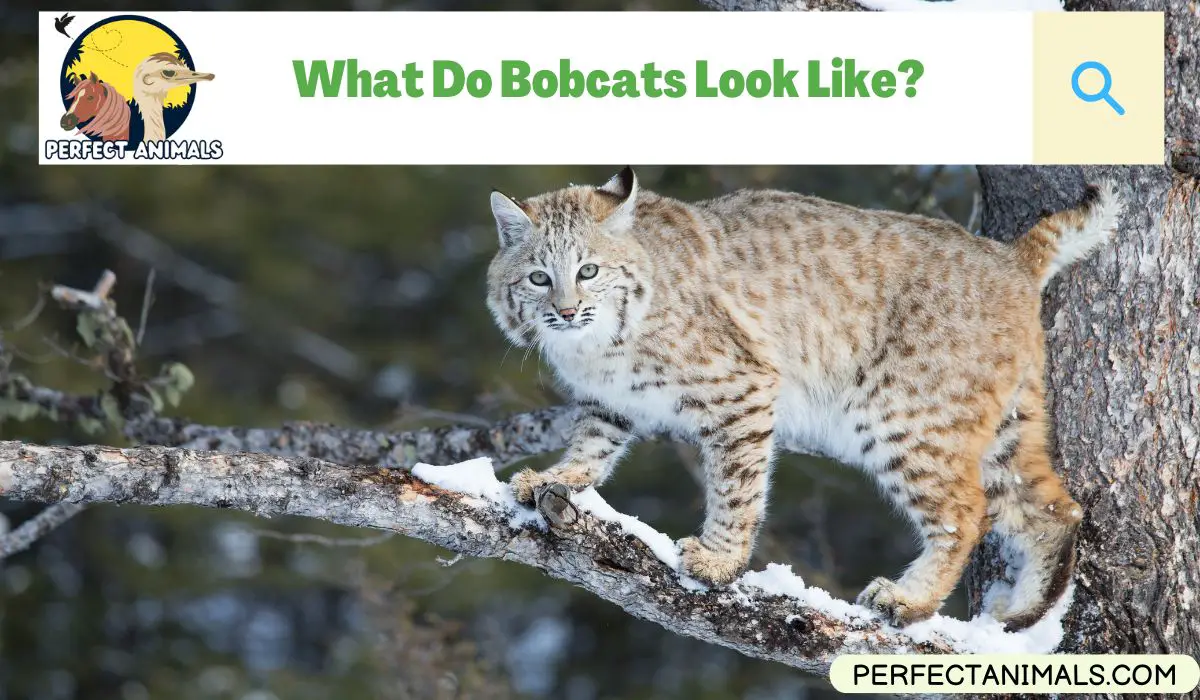Bobcats are one of the most fascinating and elusive wild cats in North America. Their distinctive appearance makes them often mistaken for domestic cats but with a more rugged and wild look.
These medium-sized predators have evolved to blend seamlessly into a variety of habitats, from dense forests to open deserts, showcasing a blend of elegance and strength.
So, what do bobcats look like? From their tufted ears and short “bobbed” tail to their spotted coats, their features are uniquely adapted to help them survive in the wild.
In this article, we’ll examine bobcats’ physical characteristics, including their size, coat patterns, and other features that make them remarkable creatures.
What Do Bobcats Look Like?
Size and Shape
Bobcats are truly striking creatures, and their size plays a big role in how they look.
On average, they range from about 2 to 3 feet long, not counting their tail. While that’s roughly the size of a large dog, their build is sleek and muscular, giving them an athletic appearance.
Weighing in at around 15 to 30 pounds, they are heavier than a housecat but lighter than a cougar, making them well-suited for fast, stealthy movements.
If you’ve ever seen a domestic cat, you might notice the bobcat’s size difference, as it’s larger and built for a more rugged life in the wild.
Their compact body and strong legs are designed for agility. Bobcats are excellent jumpers and climbers, and their muscular shape allows them to quickly escape danger or leap onto prey.
It’s fascinating to see how their body shape supports their lifestyle as hunters, from navigating dense forests to scaling rocky cliffs.
You can’t help but admire how their body is perfectly designed for their environment.
When you imagine a bobcat, think of a wild cat with the strength of a lion, but scaled down. They’re much more than just big cats; they are finely tuned predators with a body made for survival. Their size may not be as intimidating as larger cats, but it’s just right for the environment they thrive in.
Fur and Color
The fur of a bobcat is one of its most striking features. Their coat is a mix of light brown, grayish, or reddish colors, often dotted with dark spots or stripes that help them blend in with the environment.
This camouflage is perfect for an animal that needs to stay hidden while hunting.
The spots, often in shades of brown and black, cover most of their body and are especially visible along their back and sides. It’s incredible how these markings help them disappear into the wild.
The underside of the bobcat is usually lighter in color, ranging from a soft cream to white. This lighter fur is less noticeable and aids in camouflage when they are moving through the underbrush.
It’s fascinating to think how this natural color pattern works to keep bobcats unseen by both prey and predators alike, making them elusive in their habitat.
When you see a bobcat in the wild, their fur may look soft and thick, especially in the colder months when they grow a thicker coat for warmth.
But the color and texture of their fur are also incredibly functional, allowing them to thrive in both hot and cold environments. It’s nature’s way of ensuring they remain stealthy, agile, and perfectly adapted to their surroundings.
Face and Ears
The bobcat’s face is another remarkable feature that sets it apart from other cats. Their face is broad, with a short muzzle that makes them appear more intense and fierce.
It’s the kind of face that says they’re not just a wild cat but a skilled hunter, built for life in the wild. Their eyes, sharp and focused, are full of curiosity and alertness, always scanning their surroundings for any movement. It’s hard not to notice how their eyes seem to see right through you, giving them an air of mystery and power.
Their ears are equally fascinating. Pointed and sharp, they stand out with black tips and small white spots on the back.
These unique markings not only make their ears visually striking but also help them communicate with each other.
When bobcats are in the wild, these distinctive ears can be seen twitching or rotating to catch sounds from all directions, making them expert listeners.
What makes the bobcat’s face even more interesting is the way it reflects its personality—strong, confident, and always aware of its environment.
Their facial features, from the broad shape to the pointed ears, make it easy to tell that they are built for survival. They have a look that is both captivating and intimidating, which is exactly how they need to be in the wild.
Tail (The “Bob” in Bobcat)

One of the most distinctive features of a bobcat is its short, “bobbed” tail, which is where the cat gets its name. Measuring only about 6 to 8 inches, the tail is much shorter than that of a domestic cat, but it’s still a powerful part of the bobcat’s body.
The tail helps with balance, especially when the bobcat is jumping, climbing, or making sharp turns while chasing prey. It’s a key feature that highlights their agility and stealthiness.
The bobcat’s tail also has dark, black bands around it, often making it easy to spot from a distance. These bands give the tail a striped appearance, adding to the bobcat’s unique look.
While the tail is short, it plays a significant role in communication and balance, ensuring that the bobcat can stay in control no matter what terrain it is moving through.
In addition to being functional, the bobcat’s tail is a key part of its identity. It’s what sets them apart from other wild cats and gives them their name.
A bobcat without its tail would look incomplete, and it’s this feature that helps them stand out in the wild, both visually and in terms of their behavior.
Legs and Paws
When you look at a bobcat, it’s clear that its legs are built for action. They are short but incredibly strong, designed to help the bobcat leap and run with impressive speed. Whether it’s jumping onto a rock or chasing after prey, their legs are the perfect combination of strength and agility. The muscular build in their legs ensures they can make quick, powerful movements when they need to, making them excellent hunters in their natural environment.
Bobcats also have large, padded paws that are specially designed to help them move silently through various environments. Their paws are perfect for gripping onto rocky surfaces or silently stalking prey in the forest. The pads on their paws help them remain unnoticed, making them silent hunters that can sneak up on their prey without making a sound.
What’s even more impressive is how their paws help them navigate through different terrains. Whether they’re walking on snow, mud, or rocky ground, their large paws provide stability and traction, making it easier for them to cover large areas in search of food. Their legs and paws are the ultimate tools for survival in the wild, allowing them to hunt, travel, and explore without drawing attention to themselves.
Overall Look and Behavior
When you put all of these features together, the bobcat’s overall look is nothing short of wild and beautiful. From its muscular body to its sharp face and bobbed tail, everything about this cat says “survival.” They are perfectly built to live in the wild, and their physical traits reflect their ability to adapt to nearly any environment. Whether they are running through the woods or quietly stalking prey, their appearance is a constant reminder of their strength and independence.
Bobcats aren’t just beautiful to look at—they are incredibly agile, silent, and stealthy hunters. Their ability to move without making a sound is matched only by their ability to leap, climb, and escape danger with ease. This combination of strength and grace allows them to be at the top of their game as predators, and their appearance reflects this perfectly.
As solitary animals, bobcats move through their territory with a quiet confidence, never needing to compete for attention. Their behavior, much like their appearance, is all about efficiency, speed, and skill. Every part of their body is perfectly suited for their wild lifestyle, and it’s truly amazing how they’ve evolved to thrive in so many different environments.
Final Thoughts
In this article, we’ve explored what makes bobcats such fascinating creatures. From their sleek and muscular bodies to their distinctive fur and short, bobbed tails, bobcats are uniquely adapted to their environment. Every feature of their appearance, from their sharp eyes to their strong paws, reflects their ability to thrive in the wild.
Whether it’s the spots on their fur for camouflage, the sharpness of their triangular face, or their silent, agile movements, bobcats have evolved into some of nature’s most skilled hunters. Their appearance is not just for looks—each detail helps them survive in diverse habitats, from forests to deserts.
By breaking down the bobcat’s features, we hope you now have a better understanding of this remarkable animal and its role in nature. Next time you’re outdoors, keep an eye out—you never know when you might spot one of these stealthy creatures in action! Bobcats are a true testament to nature’s incredible design.
Related Article – Are Foxes Nocturnal?
Resources – (for further reading)
Smithsonian’s National Zoo and Conservation Biology Institute – Bobcat
National Geographic Kids – Bobcat Animal Profile

Brittney , a devoted exotic pet enthusiast, showcases her profound passion for the animals through her role as a veterinary technician. With a strong background in caring for a diverse array of animals, she shares her expertise by crafting engaging articles about exotic pets for our blog.

